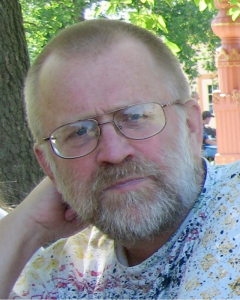Podcast
Download by “right-click and save content”
The post Dasha Mula Tattva 2 – Scripture is the only way to know inconceivable Absolute Truth appeared first on The Spiritual Scientist.
Websites from the ISKCON Universe
Podcast
Download by “right-click and save content”
The post Dasha Mula Tattva 2 – Scripture is the only way to know inconceivable Absolute Truth appeared first on The Spiritual Scientist.
Gita verse-by-verse study Podcast
Download by “right-click and save content”
The post Gita 08.17 – The immortal is not eternal appeared first on The Spiritual Scientist.
(Kadamba Kanana Swami, 05 October 2015, Melbourne, Australia, Srimad Bhagavatam 3.14.22)
 In the 11th canto of Srimad Bhagavatam, it says that astrology is relevant to that which takes birth because after all, astrology is about making a birth chart. And then it says that the soul never takes birth. This kind of gives us the final conclusion on astrology; it is not relevant to the soul. Therefore through astrology, one cannot actually determine the destiny of the soul but one can determine the destiny of the body, the destiny of the mind and one can determine destiny according to karma.
In the 11th canto of Srimad Bhagavatam, it says that astrology is relevant to that which takes birth because after all, astrology is about making a birth chart. And then it says that the soul never takes birth. This kind of gives us the final conclusion on astrology; it is not relevant to the soul. Therefore through astrology, one cannot actually determine the destiny of the soul but one can determine the destiny of the body, the destiny of the mind and one can determine destiny according to karma.

Cooperate!
Bhaktimarga swami: If there could ever be a New Year’s resolution that resonates universally, I would say it could be to step-up on cooperation. Cooperation appears to be a high symptom of love.
Our guru, Srila Prabhupada, had remarked that love is demonstrated by the ability to work as a team.
In other words, cooperate.
The post Lunch at Sanjaya Prabhu’s appeared first on SivaramaSwami.com.

HG Yamuna Devi Dasi Tribute (34 min video)
Srila Prabhupada: I know that if you maintain the association of devotees your life will be happy and perfect. That is the version of the sastra that the most important thing for spiritual realization is the company of realized souls or pure devotees of the Lord.
 By Haripada Dasa
By Haripada Dasa Once during the rasa dance, when Radharani left the arena and Krishna went to seek Her out, one of the dear friends of Radharani addressed Krishna thus: "My dear Krishna, You have been very much obliging in serving the form of our Sri Radharani, and now You have left all the other gopis to search for Her. Please allow me to inquire how You want Her to treat You." This is an instance of feeling pride on account of exquisite beauty. Sometimes Radharani felt pride within Herself and said, "Although the cowherd boys prepare nice flower garlands for Krishna, when I present My garland to Him, He becomes struck with wonder and immediately accepts it and puts it on His heart." Similarly, in the Tenth Canto, Second Chapter, verse 33, of Srimad-Bhagavatam, Lord Brahma says, "My dear Madhusudana, persons who are pure devotees of Your Lordship actually feel Your ecstatic friendship, and as such they are never vanquished by enemies. They know they are always protected by You, and so they can matter-of-factly pass over the heads of their enemies without any care." In other words, one who has taken complete shelter under the lotus feet of the Lord is always proud of being able to conquer all enemies. Continue reading "Yukta vairagya or using everything in Krishna’s service
→ Dandavats"

By Kesava Krsna dasa
Let’s face it; nobody in this material world likes to be bossed around. There is one experimental reality show called ‘Survivor’ in which contestants get stranded in some remote place far removed from modern civilization. Working in tribes, the members have to compete and cooperate at the same time. There is a process of elimination as fellow tribe members vote off those deemed as threats to their ambition to win the ultimate million dollar prize.
Those individuals, who display natural leadership traits and get things done around the camp, are usually the ones to get voted out ‘ people do not being bossed around. The canny ones however, keep low profiles; yet manipulate things to their advantage and improve their chances of winning.
This scene is quite far removed again from how things play out in the devotee community, yet Iskcon needs leaders. But how to choose them based upon what criterion has often been a thorny issue. Are we looking at spiritual advancement? Are we demanding expertise and administrative abilities? Do we consider those high in the popularity stakes? How about those with strong personality types? Or even those who are together and balanced and so on.
If we look back at our disciplic succession we will find unlikely leaders and acaryas who may not fit our modern day portrayal of leadership as required by Iskcon. Our largely vaidhi and sadhana based lifestyle would probably not accommodate them.
If we take Srila Gaura Kishora Dasa Babaji Maharaja for instance, would he fit in comfortably into one of our temples as a leader? He isn’t just a leader, but an acarya recognizable by those possessed of pure spiritual vision. Yet his penchant for seclusion, constant chanting and avadhuta behavior may not endear him very much to those who see with external vision. In fact, hardly anyone would recognize his true worth, and his apparently unproductive contribution to the temple may result in his sadly being asked to leave the temple.
His leadership is borne of sheer purity and renunciation, and he performed spiritual life in his siddha-deha in tune to the asta-kaliya times of the day. He wasn’t a coordinator or anything like that, but his command would be sacrosanct to Srila Bhaktisiddhanta Sarasvati Thakur who coordinated and organized thousands of disciples.
From the above example we can see that being a leader is not all about organizing, coordinating and administrative work. Needless to say, those who are vaisnavas are above all other designations. If a sannyasa or brahmana is a leader of the various orders of life, this role is fulfilled more by exemplary behavior, giving wise counsel, advising, teaching and so on.
When the sannyasa and brahminically minded devotees engage in affairs of management more suited for a ksatriya administrative type, even though vaisnavas can bypass the varna and asrama roles, it does not bode well for any prospect of implementing varnasrama-dharma within Iskcon. We either stick with what we are doing now, or forget about varnasrama talk for a couple more decades.
It usually happens if someone excels in a particular service, they become party leaders or departmental heads. Then we get some individuals who are competent or educated, will also be given a chance to manage. Then the vexing question must arise, does the position being held equal the spiritual advancement of the devotee? We can turn the question around and ask, does one have the spiritual qualifications for a certain managerial or important position?
The questions are raised because in many cases there seems to be a fixation on awarding outward results with responsibility, as opposed to apparent meager results shown by more inward brahminical devotees. Yet both types are leadership material in their own rights. Then we could have a scenario where a less spiritually qualified person is dictating to a more spiritually qualified devotee under his care, which has happened before.
So really there are two types of leaders under discussion, and they are not always being occupied in the right places. The GBC can be likened to a collective king or monarchy, but we do not have an advisory council for this body. Do we need one?
Not too long ago there were times when Srila Prabhupada countered and overruled certain policies endorsed by the then GBC. Was he not playing the sagely advisory role then, even though it was his solemn right to do so? In other words, the sannyasis and brahminical devotees who are presently managing the GBC affairs which could be done by trained sober ksatriya devotees can find their rightful place in an advisory council for the GBC.
This is not to say the GBC loses its power. It still retains the ultimate managerial authority. In politics the general politicians run the country. But they do not decide on every single bit of legislation that passes before them. The important ones are passed on to the upper chamber, or upper house (House of Lords) for the wise experienced men to deliberate and pass judgment. It goes back to parliament, or in Iskcon’s case, the GBC, where it is passed into law or whatever. By the way, this British system has endured for centuries, so something must be right.
Such a system in Iskcon will provide equitable employment for the brahmanas and sannyasis in the upper house of the advisory sagely committee, and the naturally gifted ksatriya devotees to run the GBC. Should this ever happen it will kick start the implementation of varnasrama-dharma at it would have started from the top.
There has been talk of a leadership academy to help train future leaders in Iskcon. While nothing can compensate for real ‘tread of the mill’ training learnt through the local temples with a little outside ‘pundit’ management know-how, nothing can beat following the core principles set by Srila Prabhupada. We want the right devotees to be in the right places.
If any insinuation of exclusivity is attached to the academy it will brew resentment and other unwanted feelings. In the military and corporate world the officers and management have their own canteens, bathrooms and other amenities separate from the gentry. We cannot emulate their ways.
While doing service in management, if it is taxing enough to interfere with basic hearing and chanting, we cannot always plead for Srila Prabhupada’s example of managing Iskcon and doing many other things too. He was after all a self realized soul. For him, managing or living in a grass hut were the same, his equilibrium stayed intact. For a Sadhaka busily engaged in management while trying to be self-realized, can be a slower way if the basics are compromised.
The devotees within Iskcon try to develop humility and glorify other devotees. This very liberal behavior can empower a leader among us who must have his senses under control. The humility of the devotees can cause a leader to abuse his position. It should go without saying that choosing the right devotees for leadership positions is a serious duty.
The ideal blend of being together and organized, and spiritually serious should put one up for candidature. It may be difficult to detect unwanted motivation in a leader until some unpleasant behavior is exposed. But then, if it comes to choosing between someone who wants to be a leader and someone who doesn’t, would it not be better to go for the reluctant leader?
Ys, Kesava Krsna dasa.

Dear fellow Vaishnavas,
Throughout the years we have all sought natural cures for many of the illnesses we have had. In doing so, at times we have met with great difficulty trying to decipher which of the cures would actually be effective, often spending an undue amount of time in research or experimentation, even failing in the end. With the blessings of HH Prahladananda Swami, ISKCON’s Minister of Health, we are beginning a website called “Cures That Work.” It will consist of personal testimonials from devotees who have been successful in treating their illnesses or others’ effectively with natural remedies. If you or an acquaintance from any walk of life would like to submit an account, we encourage you to do so. Please include as many details as possible. Upon acceptance, your submission will be posted on the site as soon as we are up and running, which we hope will be by the end of January. The testimonials should be in English and include your name and also permission for further contact if you are agreeable to being reached by those who seek more information.
After this beginning phase gets established, we are considering expanding the website to provide additional resources, so we welcome any ideas you might have. Bhagavan das (GdG) is our project manager, and he will be receiving all testimonials and suggestions. He can be reached at bhagavandas.gdg@gmail.com.
We are praying that the devotees will be benefited by this undertaking.
Yours in Srila Prabhupada’s service,
Gunagrahi das Goswami

“Fellowship With Devotees” (video)
Program at ISKCON Boston Temple. Kirtan and Lecture by Her Grace Urmila Devi Dasi.
Watch it here: https://goo.gl/GP3iOA

HG Shyamasundar Dasa and HG Malati Devi Dasi in Sacramento (video)
Srila Prabhupada: You are all the limbs of my body. Unless you cooperate, my life will be useless. Letter to Brahmananda, July 17, 1968.
Watch it here: https://goo.gl/YITpGP

Preaching in Bangalore (Album with photos)
Srila Prabhupada: Others, who are not devotees, may think, “How can people devote so much time simply to talks of God?” The chanting of the Hare Krishna mantra is simply the repetition of three words, Hare, Krishna, Rama, but still devotees can go on chanting this Hare Krishna mantra twenty-four hours a day without feeling fatigued. (Srimad-Bhagavatam, 4.13.1Purport)
Find them here: https://goo.gl/SjV4v7
The post UK sankirtana festival lecture (Part 2) appeared first on SivaramaSwami.com.

A happy recipient of the Holy Name! (1 min video)
So enchanting, rhythmic and joyful!
Completely spontaneous. Just like that…
Watch it here: https://goo.gl/RQYj2D

January 10. ISKCON 50 – S.Prabhupada Daily Meditations.
By Satsvarupa dasa Goswami.
Our remembrance of Srila Prabhupada is more than nostalgia for a wonderful person who was here, but who is now gone. Remembering Prabhupada is the cutting edge of our life at every moment.
Bhaktisiddhanta Sarasvati Thakura said that when one forgets his guru, then all one thinks of is, “I run in a hurry for my bath. I become busy for preventing a cold. I run after other occupations different from the service of Sri Gurudeva.”
How do I remember Prabhupada? First of all, I remember that there was (and is) such a person as Prabhupada. Descartes said, “I think, therefore I am.” That was his bottom line of truth. Our bottom line is, “I remember Prabhupada, therefore I am.” I am now in spiritual life because my spiritual master delivered me from darkness. I do not forget that. I remember him and follow him. Basic remembrance of Prabhupada refers to the promises we made him at our initiation – the four rules and sixteen rounds and other obligations. We aspire to be Krishna conscious and to read Bhagavad-gita and his other books. We aspire to serve among his devotees.
Read the entire article here: http://www.dandavats.com/?p=20490&page=4

Supporters and well-wishers of ISKCON who attended a 50th Anniversary gala event in Ahmedabad sponsored over 12,500 Bhagavad-gitas as part of the December marathon in India. Devotees at the Ahmedabad temple had organized an event to celebrate Gita Jayanti at Regenta Hotel, which was attended by over 200 business leaders. The event was hosted by Rajesh Karia, owner of Regenta Hotel.

Concert in Sao Paulo Brasil. Holi Festival Of Colors 2014. Music by Titiksava Karunika Das. For more info on Namrock please visit: http://www.namrock.com

The new book by Chaitanya Charan Das features 121 reflections on the Bhagavad-gita that make its insights appreciable in brief, relishable nuggets of wisdom. The book published in hard copy on Janmashtami 2015 is already nearing the end of its first print run and will go for the second print soon. Recently released on kindle, it is now available free on January 10th.
The post Daily Darshan : January 10th, 2016 appeared first on Mayapur.com.
15 034 Panca Tattva Broke Open Storehouse Of Krishna Prema CC Adi 07 20 21 FL GP dt 15 03 05 1
Do the wise also experience pain, suffering and difficulty? What is death? What ends and what doesn’t? What is duty, and does taking care of children have any relation to becoming enlightened? Krishna and Arjuna discuss all these topics and more in section 11~15 of Gita’s Chapter Two.
Gita verse-by-verse study Podcast
Download by “right-click and save content”
The post Gita 08.16 – The world is like a jail or hospital – returning to it is undesirable appeared first on The Spiritual Scientist.
His Holiness Bhakti Charu Maharaj visited Surat on 3rd and 4th of January 2016. HH Bhakti Prema Swami Maharaja and a group of devotees from Ujjain accompanied Maharaj. ISKCON Surat yatra welcomed Maharaj at Sri Sri Radha Damodar temple, where Maharaja delivered the Sunday feast lecture. Maharaj first sang the song “Krishna Jinaka Naam” and explained […]
The post Bhakti Charu Swami visits Surat appeared first on Bhakti Charu Swami.

Hacha Puri and the Peace Formula!
Govinda Swami: Saci, Vrindavan Kirtan, and I arrived in Moscow yesterday afternoon.
On a chilly Moscow afternoon we were warmly received by Radha Raman Giridhari, Sri Rupa Manjari, Sarasvati, and Master Baladev.
We then travelled from west Moscow to south to the home of Nandi Mukhi and Radha Preyan to spend the night. They are Georgian devotees that date back to the early, early days of ISKCON during the Soviet Union.
They are both from well-to-do families during Soviet days and their choice of Krishna consciousness was not the most pleasant thing for their folks to digest.
Consequently they spent years on the run. Preaching, running, preaching, running, and dodging the KGB at every step.
Radha Preyan was once captured and put in a KGB prison. One day an opportune moment came and he jumped out of a second story window and never stopped running.
One evening last summer Vrindavan Kirtan and I sat with Nandi Mukhi and Radha Preyan completely enrapt in hearing their ecstatic preaching stories.
So, though I had requested our standard diet of steamed veggies, soup, and salad … when we arrived we were treated with Georgian hospitality to a wonderful feast of Georgian cuisine.
We ate delicious things, the names of which I cannot even pronounce, and, they were all accompanied with the king of Georgian mineral waters Borjomi.
Being the hooligan that I am I kept requesting them to bring Georgian wine, and Radha Raman Giridhari would say the funny exotic names of the Georgian wines he had drank in his youth.
But, the undisputed king of all of the preparations was the “Hacha-Puri.”
This is a delicious bread, baked with huge amounts of white cheese till the cheese browns on top, served straight from the oven.
It is so delicious I won’t even attempt to use more words to describe.
For dessert there were a few cakes and an intriguing Georgian pudding type preparation made from boiled sweet red grape juice.
Saci Suta Das passed out, Vrindavan Kirtan Das kept slightly moaning and rubbing his belly, and I was carried upstairs and put to sleep by Gopijanavallabha Das.
Everywhere we travel the devotees are always so gracious, hospitable, and filled with love.
Just in the past 18 days we have been overwhelmed with the kindness of the Texas Krishna’s, Haridasa .. the Texi-Chino wonder devotee, the Singh clan in Tennessee, our beautiful gracious and cultured devotees in Dubai … and now back to Mother Russia.
This country is a wonderland.
I remember when I was a kid I was programmed to think that all Russians had horns on their heads and a long spiked tail.
Well, when I came here I was humoured to learn that they were programmed the same way about us
But really, the folks who live here are some of the most open and big hearted people that I have ever met. And, the culture of hospitality is beyond belief.
Well, maybe we should make an arrangement for the big powerful people at the top of the world to get together and have a few Hacha Puri at Radha Preyan’s home .. in the association of vaisnavas.
I bet if they did that it would work wonders to help them see one another without the “horns on the heads and spiked tails.”
Well, we are out the door at 7 AM to Kazan, Tatarstan for another ocean of Russian vaisnava graciousness and hospitality !!
Hare Krishna !!

Lord Chaitanya’s Moon is Rising (5 min video)
“Lord Caitanya’s moon is rising, and you know it’s not at all surprising, that we’re singing in the street, telling everyone we meet, we’re going home.”
Watch it here: https://goo.gl/OayGxR

Madhava Gosh Dasa, born October 25th, 1949, left his body peacefully at his home in New Vrindaban, WV, on January 2nd, 2016, at the age of 66.
Madhava Gosh was a pioneer New Vrindaban inhabitant, having lived in the dhama since 1973. Inspired by the instructions of his spiritual master, Srila Prabhupada, he was a lifelong activist of local agriculture and cow protection and implemented an endowment fund to care for the cows at New Vrindaban.
Serving as one of the farm hands at New Vrindaban since the early days, Madhava Gosh spent decades of his life gardening and working on simple living projects.
When asked a month before he passed away what he felt was his best accomplishment he said, “Planting the trees, because the fruits are not enjoyed by the planter, but by those to come in the future. And these trees will outlive most of us.”
Madhava Gosh had a 10 year plan to plant 1,000 fruit and nut trees in the New Vrindaban dhama area, as part of the program for sustaining the Deities and devotees in the future, to provide perineal “crops” to produce food, year after year after year. Madhava Gosh planted with an assistant well over 350 trees since 2010. 150 trees were planted by householders living in New Vrindaban who take care of the trees. There are plans to resume this project in 2017.
Back in May 2006, Madhava Gosh had a liver transplant, due to his organ failing. His son Marken donated half of his own liver to sustain his father. Madhava Gosh did lots of service with his son’s gift and the “extra’ time.
The past two years Madhava Gosh has been struggling with post-transplant liver degeneration and other side effects. Both his kidneys failed and he had been on dialysis 3 times a week for over a year. With all the physical complications he was dealing with, he became weaker and weaker. He also came to understand that his lungs were already beginning to slowly deteriorate and filling with liquid.
Understanding that he was slowly dying and not wanting to be a burden on those caring for him, Madhava Gosh chose to go off dialysis on December 24th, 2015.
The week before his departure, Madhava Gosh’s daughter, Vraja, looked after his physical care. Many community members as well as some local neighbors visited Madhava Gosh. Devotees came and shared old pastimes and laughed with Madhava Gosh and expressed their hearts. They played instruments and sang and read Krishna book to Madhava Gosh. Srila Prabhupada’s singing was played non-stop for the last week.
Then on January 2nd, it seemed as if Krsna took direct control of all the events that followed, as everything seemed to be perfectly coordinated. The sun shined through the window. Three devotees, including Vraja, sat peacefully chanting by Gosh’s bedside while a recording of Srila Prabhupada and the Hare Krsna Temple album played in the background. That morning the samsara prayers were sung and then the Govindam prayers and some of the Brahma Samhita. Srila Prabhupada’s garland had been placed at Madhava Gosh’s head.
His daughter swabbed fresh Tulasi leaves from Sri Sri Radha Vrindavan Chandra’s lotus feet, sprinkled in the Ganges water into Madhava Gosh’s mouth. Madhava Gosh, who had not moved for 24 hours, suddenly lurched his right arm forward, and his right hand, which was inside his japa bag, grabbed his japa beads tightly. Gosh had a tear in his eye, took a labored breath. His daughter Vraja said, “It is OK, you can leave” and his next breath was his last. He left his body at 11:23 am, January 2, 2016. Srila Prabhupada’s garland was moved to encircle his face and neck. Shortly after his glorious passing, Srila Prabhupada was singing the Nrisimhadeva prayers of protection in the background.
Madhava Gosh is survived by his wife of 41 years, Vidya Dasi; five children, Manjari, Madhu, Vraja, Marken & Tulasi; three grandchildren, Mary, Gracie & Sydney; and many friends.
Those wishing to do something in honor of Madhava Gosh could plant a fruit, nut or flowering tree or contact ECO-Vrindaban at www.facebook/ECOVrindaban, which specifically funds the projects for the cows and garden care at New Vrindaban.
The community members are grateful that Madhava Gosh generously gave his time and energy to develop, maintain and preserve this New Vrindaban project. “Thank you Madhava Gosh Prabhu, your spirit will live on through the fruits of your lifelong service contributions.”

By Kavicandra Swami
Concern for the environment is considered by many to be very high, even spiritual, consciousness.
The citizens will suffer greatly from cold, wind, heat, rain and snow. They will be further tormented by quarrels, hunger, thirst, disease and severe anxiety.
SB 12.2.11
As devotees we may not realize our responsibility for the current problems nor understand what we can do about it. Are we peforming the sankirtan yajna enough?
When the Hare Krsna mantra is chanted by many men together, the chanting is called sankirtana, and as a result of such a yajna there will be clouds in the sky (yajnad bhavati parjanyah [Bg. 3.14]).
In these days of drought, people can gain relief from scarcity of rain and food by the simple method of the Hare Krsna yajna. Indeed, this can relieve all of human society. At present there are droughts throughout Europe and America, and people are suffering, but if people take this Krsna consciousness movement seriously, if they stop their sinful activities and chant the Hare Krsna maha-mantra, all their problems will be solved without difficulty.
Ref. VedaBase => SB 9.1.17
Headlines like the following are becoming more prominent. Many are admitting the problem, but no one has a solution. Water is Krsna’s energy and devotees have the potential to really do something.
Many states seen facing water shortages
By BRIAN SKOLOFF, Associated Press Writer
Fri Oct 26
WEST PALM BEACH, Fla. – An epic drought in Georgia threatens the water supply for millions. Florida doesn’t have nearly enough water for its expected population boom. The Great Lakes are shrinking. Upstate New York’s reservoirs have dropped to record lows. And in the West, the Sierra Nevada snowpack is melting faster each year. Across America, the picture is critically clear — the nation’s freshwater supplies can no longer quench its thirst.
• The government projects that at least 36 states will face water shortages within five years because of a combination of rising temperatures, drought, population growth, urban sprawl, waste and excess.
• “Is it a crisis? If we don’t do some decent water planning, it could be,” said Jack Hoffbuhr, executive director of the Denver-based American Water Works Association.
• Water managers will need to take bold steps to keep taps flowing, including conservation, recycling, desalination and stricter controls on development.
Srila Prabhupada spoke boldly and confidently on this subject
“Prabhupada: …sankirtana, then water will come. You haven’t got to do anything. Otherwise the words of Gita will be false. Yajnaih… Yajnad bhavanti parjanyah. The formula is there. You perform yajna and the water will be supplied. They are not performing yajna.
Dhananjaya: So then it’s very important to perform twenty-four-hour kirtana here.
Prabhupada: Oh, yes.
Devotee (2): From that, then, the rains will be produced.
The following is very important. Pleasing Krsna is the essential need. If we work for material benefit, it may not work.
Prabhupada: Yes. But we should not chant for rain. That will automatically come. But you should chant for pleasing Krsna.”
I personally heard this one. I often forget what I hear from Srila Prabhupada, but this statement was spoken with great force and I often remember it. I don’t say that I can apply, but I do remember it.
You may have heard of “Murphy’s Law”. There are many versions of it, such as
Washing your car constitutes a rain dance to the raining gods.
All the laws above were sent by Natalie.
Corollary: washing a car to make it rain will cause a drought.
Here is more from His Divine Grace.
Makhanlal: There’s some rumors that there will be a drought in the United States, a very severe drought.
Tripurari: But by the devotees chanting they would never have to…
Prabhupada: Yes, everywhere.
Makhanlal: Even if there was drought for the nondevotees, the devotees would, automatically wouldn’t have to worry about such a thing.
Prabhupada: [break] …stopped, then your whole business stop. Imagine if these hills were green. How much foodstuff would have been available both for the animal, for the man. All dry, all dry. People should immediately accept this chanting to solve this problem. [break] And the yajna means yajnaih sankirtana.
>>> Ref. VedaBase => Morning Walk — April 23, 1975, Vrndavana
In 1972, the South Indian state of Andhra Pradesh was stricken by a severe drought that affected millions. Hoping that the International Society for Krishna Consciousness would provide assistance, T. L. Katidia, Secretary of the Andhra Pradesh Relief Fund Committee, wrote to Srila Prabhupada. Srila Prabhupada responded with this surprising and edifying letter.
Therefore if you want to perform relief work simply by collecting funds, I think that it will not be successful. You have to please the supreme authority, and that is the way to success. For example, due to the performance of sankirtana here, the rain has begun to fall after a drought of two years. The last time we performed a Hare Krsna Festival in Delhi, there was imminent danger of Pakistan’s declaring war, and when a newspaper man approached me for my opinion, I said there must be fighting because the other party was aggressive. However, because of our sankirtana movement, India emerged victorious. Similarly, when we held a festival in Calcutta, the Naxalite [Communist] movement stopped. These are facts. Through the sankirtana movement we can not only get all facilities for living, but also at the end can go back home, back to Godhead. Those who are of a demoniac nature cannot understand this, but it is a fact.
I therefore request you, as leading members of society, to join this movement. There is no loss on anyone’s part for chanting the Hare Krsna mantra, but the gain is great. According to Bhagavad-gita (3.21), what is accepted by leading men is also accepted by common men.
The sankirtana movement of Krsna consciousness is very important. Therefore, through you I wish to appeal to all the leading men of India to accept this movement very seriously and give us all facility to spread this movement throughout the world. Then there will be a very happy condition, not only in India but all over the world.
Ref. VedaBase => SSR 6c: Altruism
Guest (3): Now people… There are drought conditions, people are starving. Cattles are dying. There are no rains.
Prabhupada: Yes, because they are not God conscious, they are thinking like that.
Ref. VedaBase => Room Conversation — September 19, 1973, Bombay
Bhagavan: In France there was a big drought, terrible drought. Many animals died. So the president of the country made a speech, and all he could say in his speech was that people should try to use less water. (laughter)
Prabhupada: Oh. There was another caricature, India. So there was some drought, the same. So there was some, what is called, representation: “And there is no water. We are suffering. This is the difficulty.” “Yes, we are taking step, but next week you’ll have television.” Advancement, television. Because there was no television, so this is the advancement. Next week they have television. As if television will solve the problem. All mudhas, rascals, are very horrible condition. Chant Hare Krsna. There is no other.
Ref. VedaBase => Room Conversation — July 26, 1976, London
George Harrison: There’s been a drought in England, there’s no, very little water.
Prabhupada: This is very dangerous. Everything is now yellow.
Jayatirtha: It’s greener here than most places around, but…
George Harrison: Everything’s so dry this year, lots of trees and things dying without water.
Prabhupada: That is the punishment for this age. It is stated in the Srimad-Bhagavatam. There will be scarcity of rain and there will be scarcity of food and heavy taxation by government. And people will become mad on account of these three things. Anavrsti, durbhiksa, karopi.(?)
George Harrison: It’s getting dryer in England each year. It’s probably going to end up as a desert in another hundred years.
Prabhupada: They expect like that?
George Harrison: Well, I don’t know. I think the whole world’s changing. Somebody said it’s the pollution, leaves so much…, there’s so much of the oceans now with polluted and with oil on the top, there’s not so much evaporation anymore.
Prabhupada: Not in the ocean. It is the sinful activities of the populace. That is real problem. They are all engaged in sinful activities. Especially this innocent animal killing. These are the all reaction.
Ref. VedaBase => Conversation with George Harrison — July 26, 1976, London
Prabhupada: This is the only hope. Kirtanad eva krsnasya mukta-sangah param vrajet [SB 12.3.51]. Throughout the whole world the situation is not very good. Now there is drought, no water. All over the world. I have seen whole Europe, all the fields are now gray, no green. (Hindi)
Krishna Modi: India this year is very good rains. Beyond expectation. And also this crop is very good. (Hindi)
Prabhupada: Parjanyad anna-sambhavah. Nature’s work is there. As soon as there is sufficient rain you get sufficient crops. And yajnad bhavati parjanyah [Bg. 3.14]. Kali-yuga, this age, the yajna is hari-kirtana. Yajnaih sankirtana-prayaih. (Hindi)
Krishna Modi: Who can do this thing?
Prabhupada: We can do that. We can do that. Provided there is cooperation. Now…
Ref. VedaBase => Meeting With Member of Parliament, Mr. Krishna Modi — August 31, 1976, Delhi

Harinama Chanting in Brisbane, Australia (Album with photos)
Srila Prabhupada: Sri Caitanya Mahaprabhu says that since His spiritual master ordered Him only to chant the holy name of Krishna, He always chanted the Hare Krishna maha-mantra according to this direction (“krsna-mantra” japa sada—ei mantra-sara). (Sri Caitanya-caritamrta, Adi-lila, 7.72 Purport)
Find them here: https://goo.gl/nBP8Aj





By Carucandra Dasa.
Experience the story of Lord Narasimha as you have never seen it before.
This 84 page, full-color graphic novel will guide readers on a unique journey through a visually stunning narration of the pastime of Lord Narasimha.
The story begins with Hiranyakasipu’s torment over the death of his twin brother. Understanding that he must become more powerful in order to exact his vengeance, Hiranyakasipu uses his mystic prowess to attract the attention of the universal creator and gain his favor.
See how the story unfolds in this captivating presentation of this timeless classic of good versus evil and poetic justice.
This book is currently available in Mayapur, and will be released in North America in early May. For those of you who are not in Mayapur or North America, or who just do not want to wait for your copy, there is a great opportunity coming up that will save you both time and money.
This year, Mayapur will host it’s third International Leadership Sanga (ILS) from February 24-March 2, 2016 and ISKCON leaders from around the world will gather to take advantage of each others’ realizations, experiences, etc.
For those of you who will be attending the ILS, please consider gauging an interest for this book in your region so that you can bring sufficient copies back to your area.
For those who will not be attending, contact your local temple representative to find out if they can bring back copies for you when they return from Mayapur.
A limited number of books were printed for this first run, so if you would like to bring some copies back to your region, please reserve your copies as soon as possible so that we can print more if necessary before the event.
On top of saving on shipping fees, this first run is selling for 25% less than what it will be selling for in North America.
For more information, visit SunandaProductions.com, or email carucandradasa@gmail.com.
We hope that you enjoy this humble offering of ours on this fiftieth anniversary of ISKCON’s incorporation.
Hari, Hari!
 By Chaitanya Charan das
By Chaitanya Charan das Draupadi. Her admirable character is revealed in the most humiliating incident of her life – her disrobing by the wicked Dushasana. Though victimized in body, she refuses to be victimized in her heart. Her exceptional character transforms the lowest point in her life into the highest point. The incident in which she is the most dishonored, she emerges as the most honorable. On that dark day, her period has just ended and she has emerged after bathing, wearing a single cloth before she puts on her royal dress as the chief queen of the reigning monarch. Unknown to her, the monarch Yudhisthira has, in a rigged gambling match, lost everything, including all his property, his brothers, himself and finally her. The jeering Karna suggests that Draupadi be brought into the assembly and be disrobed publicly for she was now the Kauravas’ slave. If the Kauravas had succeeded in disrobing her, whether they would have physically violated her in the public assembly is doubtful. The atrocious idea was not just driven by lust but by power play – the Kauravas saw Draupadi not as a person, but as a tool to demean the Pandavas. Objectification of women runs through and through in the Kauravas’ attitude. They order a court messenger to summon Draupadi to the palace. Continue reading "Draupadi – dishonored yet honorable
→ Dandavats"